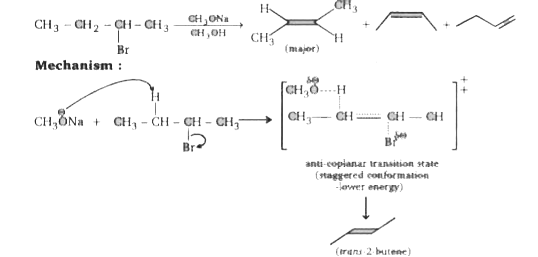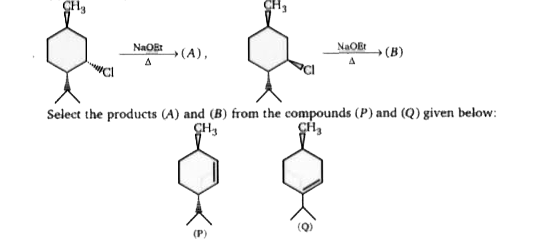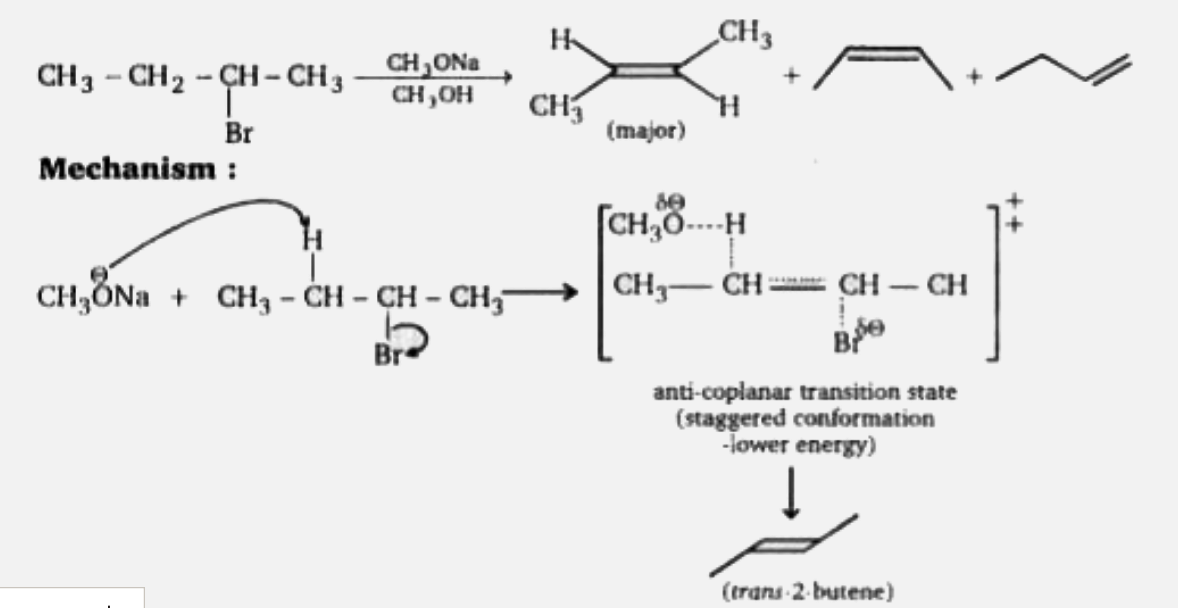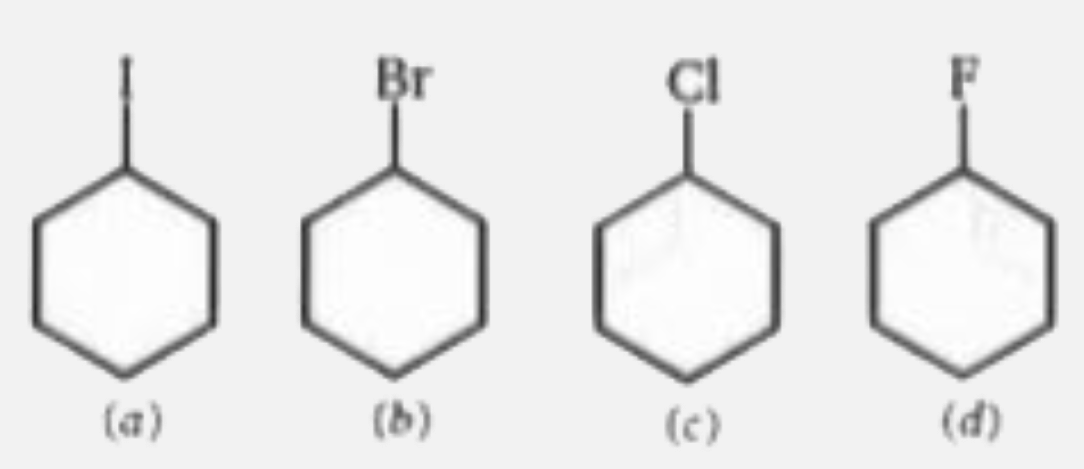Comprehension
E2 raction → Elimination bimolecular
In the general mechanism of the E2 reaction a strong base abstract a proton on a carbon atom adjacent to the one of the leaving group. As the abstracts a proton , a double bond forms and the leaving group leaves.

 Solution in Kannada
Solution in Kannada
A = P,B=P
A=Q,B= Q
A = Q,B= P
A=Q,B=P
Anti elimination
Topper's Solved these Questions
- ALKYL HALIDES (ELIMINATION REACTION) BOOK - MS CHOUHANCHAPTER - ALKYL HALIDES (ELIMINATION REACTION) EXERCISE - LEVEL-2
25 Videos
- ALDEHYDES AND KETONESBOOK - MS CHOUHANCHAPTER - ALDEHYDES AND KETONESEXERCISE - LEVEL-2
20 Videos
- ALKYL HALIDES (SUBSTITUTION REACTIONS)BOOK - MS CHOUHANCHAPTER - ALKYL HALIDES (SUBSTITUTION REACTIONS)EXERCISE - LEVEL-2
41 Videos
Similar Questions
Comprehension
E2 raction → Elimination bimolecular
In the general mechanism of the E2 reaction a strong base abstract a proton on a carbon atom adjacent to the one of the leaving group. As the abstracts a proton , a double bond forms and the leaving group leaves.

Identify the rate of reaction of given compounds in E2 reaction:

View SolutionSelect the best choice for example (A to L) from the examples (a to n) given below. Write your choice in the box given.


View SolutionStatement - 1 : Nucleophilicity order in polar-protic solvent is I−<Br−<Cl−<F−
Statement-2 : Due to bigger size of I it is less solvated in polar-protic solvent.
View SolutionAssertion: In the E_(2) elimination beta-H and leaving group should be antiperiplanar Reason In the E_(2) elimination base always abstracts unhindered beta-H .
View SolutionAmines are less reactive in substitution reactions. Their reactivity is much lesser than alcohols and alkylflourides towards substitution. Protonation of the amino group makes it a better leaving group, but not nearly as good a leaving group as a protonated alcohol. Protonated amino groups cannot be displaced by OH^(-) because it would react immediately with the acidic hydrogen which would convert it in to a poor nucleophile. The leaving group in quarternary ammonium ion has about the same leaving tendency as a protonated amino group but does not have acidic hydrogen. the reaction of a quarternary ammonium ion with hydroxide ion is known as Hoffmann elimination reaction. The leaving group is tertiary amine. Since a tertiary amine is only a moderately good leaving group, the reaction requires heat. The carbon to hwich the tertiary amine is attached is designated as alpha carbon. When the hydroxide ion starts to remove a beta H form from a quarternary ammonium ion, the leaving group does not immediately start to leave because a tertiary amine is not a good leaving group. As a result, a partial negative charge bulds up on the carbon from which the proton is removed. Which of the following compounds when subjected to Hoffmann elimination gives an alkene which can exhibit geometrical isomerism?
View SolutionAmines are less reactive in substitution reactions. Their reactivity is much lesser than alcohols and alkylflourides towards substitution. Protonation of the amino group makes it a better leaving group, but not nearly as good a leaving group as a protonated alcohol. Protonated amino groups cannot be displaced by OH− because it would react immediately with the acidic hydrogen which would convert it in to a poor nucleophile. The leaving group in quarternary ammonium ion has about the same leaving tendency as a protonated amino group but does not have acidic hydrogen. the reaction of a quarternary ammonium ion with hydroxide ion is known as Hoffmann elimination reaction. The leaving group is tertiary amine. Since a tertiary amine is only a moderately good leaving group, the reaction requires heat. The carbon to hwich the tertiary amine is attached is designated as α carbon. When the hydroxide ion starts to remove a β H form from a quarternary ammonium ion, the leaving group does not immediately start to leave because a tertiary amine is not a good leaving group. As a result, a partial negative charge bulds up on the carbon from which the proton is removed.
Which of the following statements are true regarding Hoffmann elimination?
View SolutionThe abstraction of proton will be fastest in which carbon in the following compound?
View SolutionE_(2) reaction to Elimation bimoleculaar in the general mechanism of the E_(2) reaction a sroeng base abstract a proton ,a double bond forms and the leaving group leaves Identify the rate for reaction of given compounds in E_2 reaction :
View SolutionThe removal of two atoms or groups one generally hydrogen (H+) and the other a leaving group (L−) resulting in the formation of unsaturated compound is known as elimination reaction.

In E1 (elimination) reactions the C-L bond is broken heterolytically (in step 1) to form a carbocation ( as in SN1 reaction) in which (L−) is lost (rate determining step). The carbocation (in step 2) loses a proton from the β− carbon atom by a base (nucleophile) to form an alkene. E1 reaction is favoured in compounds in which the leaving group is at secondar (2∘) or tertiary(3∘) Position.
In E2 (elimination) reactions two sigma bonds are broken and a π−bond is formed simultaneously.E2 reactions occur in one step through a transition state.

E2 reactions are most common in haloalkanes (particulary 1∘) and better the leaving group higher is the E2 reaction. In E2 reactions, both the leaving groups should be antiplaner.
E1cb (Elimination unimolecular conjugate base) reaction involves the removal of proton by a conjugate base (step 1) to produce carbanion which loses a leaving group to form an alkene (step 2) and is a slow step
R2CH−C∣X−R2'+:B−(base)→R2C=CR2
+H−B+X−
this reaction is an example of:
View SolutionThe removal of two atoms or groups one generally hydrogen (H+) and the other a leaving group (L−) resulting in the formation of unsaturated compound is known as elimination reaction.

In E1 (elimination) reactions the C-L bond is broken heterolytically (in step 1) to form a carbocation (as inSN1 reaction) in which (L−) is lost (rate determining step). The carbocation (in step 2) loses a proton from the β− carbon atom by a base (nucleophile) to form an alkene. E1 reaction is favoured in compounds in which the leaving group is at secondar (2∘) or tertiary(3∘) Position.
In E2 (elimination) reactions two sigma bonds are broken and a π−bond is formed simultaneously.E2 reactions occur in one step through a transition state.

E2 reactions are most common in haloalkanes (particulary 1∘) and better the leaving group higher is the E2 reaction. In E2 reactions, both the leaving groups should be antiplaner.
E1cb (Elimination unimolecular conjugate base) reaction involves the removal of proton by a conjugate base (step 1) to produce carbanion which loses a leaving group to form an alkene (step 2) and is a slow step Neopentyl bromide undergoes dehydrohalogenation to give alkene even though it has no β−hydrogen.This is due to :
View SolutionThe elimination reactions mainly involve three mechanism E1,E2 and E1cB. If the leaving group departs before beta -proton ( H^Theta ion) then it is E1 mechanism. If proton is taken off first before leaving group it is E1cB mechanism.The pure E2 involves both beta -Hydrogen and leaving group departing simutaneously. If acidity of beta -Hydrogen increases and leaving group ability decreases then E1cB mechanism increases. Product P is
View SolutionThe elimination reactions mainly involve three mechanism E1,E2 and E1cB. If the leaving group departs before beta -proton ( H^Theta ion) then it is E1 mechanism. If proton is taken off first before leaving group it is E1cB mechanism.The pure E2 involves both beta -Hydrogen and leaving group departing simutaneously. If acidity of beta -Hydrogen increases and leaving group ability decreases then E1cB mechanism increases. The alkene formed as a major product in the above elimination reaction is
View SolutionThe elimination reactions mainly involve three mechanism E1,E2 and E1cB. If the leaving group departs before β-proton (Ht=Θ ion) then it is E1 mechanism. If proton is taken off first before leaving group it is E1cB mechanism.The pure E2 involves both β-Hydrogen and leaving group departing simutaneously. If acidity of β-Hydrogen increases and leaving group ability decreases then E1cB mechanism increases.
Which of the following substrate will undergo fastest reaction through E1cB route
View SolutionAssertion: In the E2 elimination, β−H and leaving group should be antiperiplanar.
Reason: In the E2 elimination, base always abstracts unhindered β−H.
View SolutionThe abstraction of proton will be fastest, in which carbon in the following compound,
View SolutionIn elimination reactions, generally atoms or groups from adjacent carbon atoms in the substrate molecule are removed and a multiple bond is formed
View Solution
